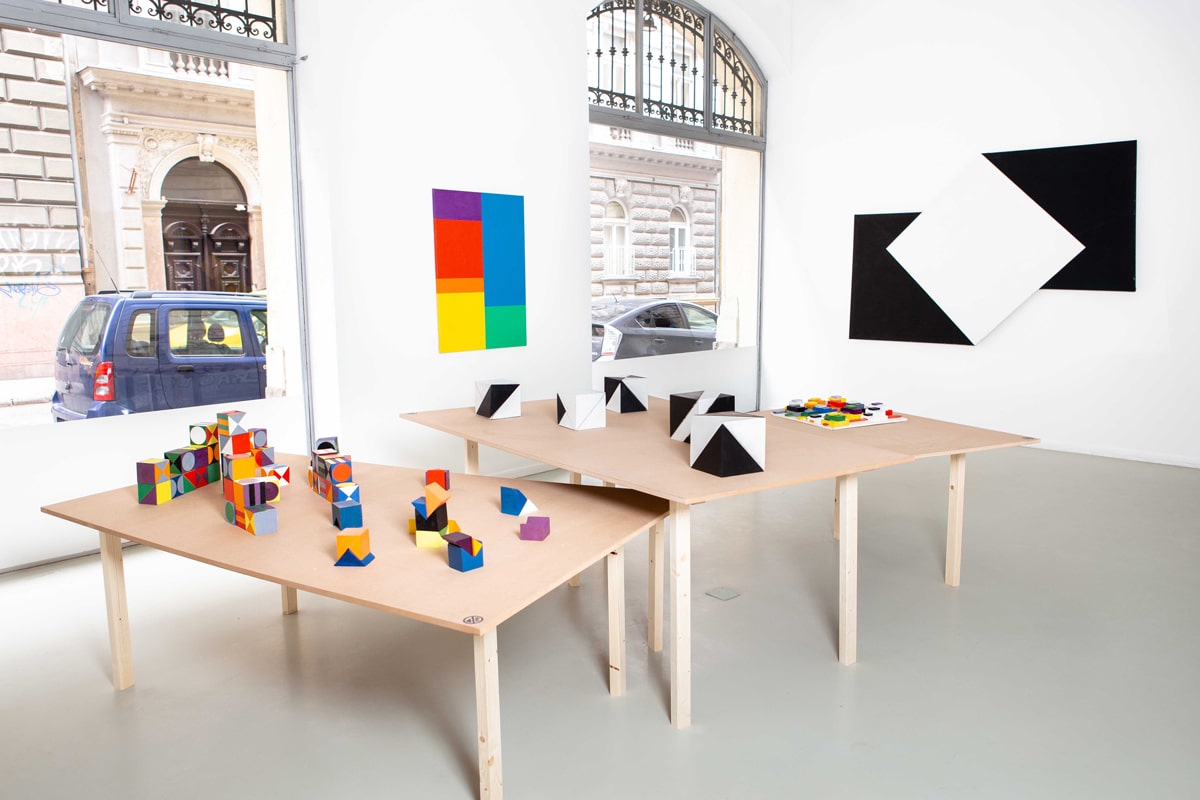
















János Fajó (1937-2018)
Visual Games
Due to Covid regulations, the opening speech of K. Horváth Zsolt will be held behind closed doors, its video documentation can be viewed on our online platforms after the opening. The public opening of the exhibition will take place on Thursday, January 27, 2022., between 3-8 PM. In accordance with current epidemiological regulations, it is obligatory to wear a mask covering the mouth and nose in the gallery space.
"Games are tools for the child's human development, and for us, it is a matter of life, a symbol of freedom of thought, let us not give it up!" - said János Fajó in the opening speech of his exhibition, entitled Visual Games, in the Józsefváros Exhibition Hall. After a year of preparation, the small gallery exhibition in September 1977 provided an opportunity to bring together independent initiatives, which through the artistic unity of material, form and function, opened up new paths in the field of visual education and environmental design. The concept of the exhibition, developed by János Fajó was the result of a consistent programme of creative and gallery management. As also ó the director of the exhibition space, Fajó developed a conscious programme to present art that shaped the landscape and the environment, and this approach was also conveyed in the exhibition of visual games. The artist believed in the need to revolutionise the game industry, which required a sensitive vision and a sophisticated thinking on the part of artists and designers.
In the fifties, game design was not yet an autonomous field, and even in the sixties, games with artistic approaches did not appear in mass quantities. The real boom in game design took place in Hungary in the 1970s. The new approach to game design was given a major impetus by the emergence of a pedagogical approach that saw games as playing an important role in education. The movements that were developing along these lines were slow to take effect, but they were complemented by a new approach that focused on the links between play and art, thus interweaving the two fields as ways of understanding and absorbing the world.
János Fajó joined this new approach to game design, which began in the 1960s and then developed more widely in the 1970s. The logical-constructive-colour-variation games of the period had their origins in the image-building methods and structural investigations of Lajos Kassák, the Bauhaus, László Moholy-Nagy and Victor Vasarely, among others. Rooted in these tendencies was a desire to understand the systems of form, as well as the new approach to design, that emerged in Hungary in the 1970s and 1980s.
A less mapped part of János Fajó's oeuvre are the works that playfully developed logical skills, the perception of color and spatial perception, which he made in the first stage of his career, in the 1960s and 1970s. Although at first this part of his activity seems to be only a side thread, in reality these works have defined his entire oeuvre and can be interpreted as a kind of zero point. The aim of the exhibition is not only to bring together Fajó's "visual games", but also to place them in dialogue with his art works from different periods (60s-70s, 80s-90s and 2000s), and to highlight how the artist's playful, spontaneous and instinctive way of forming, embodied in the tight order of geometry, the pure world of exact forms and the harmonious unity of vivid colours, has accompanied him throughout his career.
The starting point of the exhibition is one of Fajó's most emblematic early paintings, Falling Squares (1967). The work was conceived in the spirit of the artist's entire career: the simple geometric shapes of the composition are set in motion by the optical play of colours and forms, and break out of the usual static plane of painting. Fajó achieves this dynamism on the one hand through a chain of 'falling' squares, a flowchart-like representation, and on the other hand the rhythmic variation of the colours of the shapes reinforces the illusion of movement. Another kind of playfulness based on geometric abstraction is represented by works in which the 'slicing' of the picture field is literal. In his 2007 work Colour Reconstructed, an elongated shape cut out of a square shape has created another square, transforming the stark order into an asymmetrical whole. Through the act of cropping and the associated use of a restrained colour palette, he presented an unusual and bold solution to the spatial extension in painting. At the same time, there are works in the oeuvre that focus purely on forms and their interweaving and interrelationship. In the only black and white work in the exhibition, the Square Manifestation (1981), the puritan use of colour privileges the structure, and the interplay of planes and the balance between squares, with restrained elegance and rigorous symmetry, emphasise the dynamism and power rooted in formal order.
We would like to express our gratitude to the FAJÓ FOUNDATION for their ongoing support, and who made this exhibition possible. For her research on the subject, Zsanett Lépold received a grant from the FAJÓ Foundation.
The entire documentation will be available on the gallery's website as well as on our social media platforms, the exhibition can be visited during opening hours in compliance with safety regulations.
For more information on the artist or the exhibition, please contact us by email.
Curator: Zsanett Lépold
Opening: January 27, 2022, Thursday 3-8 PM
On view: January 28 – March 4, 2022
Opening hours: Wednesday-Friday 12-6 PM
Opening speech: Zsolt K. Horváth, Social Historian, professor at the Budapest Metropolitan University